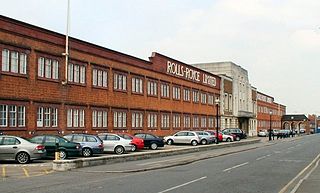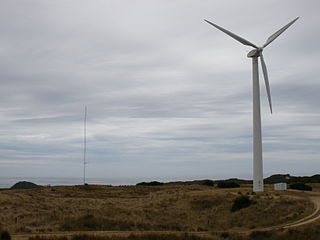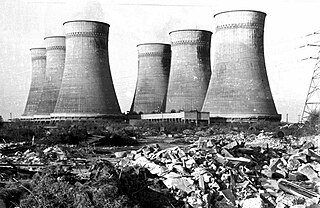
Electricity generation is the process of generating electric power from sources of primary energy. For utilities in the electric power industry, it is the stage prior to its delivery to end users or its storage, using for example, the pumped-storage method.

A power station, also referred to as a power plant and sometimes generating station or generating plant, is an industrial facility for the generation of electric power. Power stations are generally connected to an electrical grid.

Genesis Energy Limited, formerly Genesis Power Limited is a New Zealand publicly listed electricity generation and electricity, natural gas and LPG retailing company. It was formed as part of the 1998–99 reform of the New Zealand electricity sector, taking its generation capacity from the breakup of the Electricity Corporation of New Zealand (ECNZ) and taking retail customers from three local power boards in the Lower North Island. The New Zealand Government owns a 51% share of the company.

Constellation Energy Corporation is an American energy company headquartered in Baltimore, Maryland. The company provides electric power, natural gas, and energy management services. It has approximately two million customers across the continental United States.

The Brisbane Powerhouse is a performing arts and cultural centre which is housed in a former power station in the Brisbane suburb of New Farm in Queensland, Australia. The venue offers an array of live performances, visual art displays, exhibitions, festivals, and free community events.

Rolls-Royce Limited was a British luxury car and later an aero-engine manufacturing business established in 1904 in Manchester by the partnership of Charles Rolls and Henry Royce. Building on Royce's good reputation established with his cranes, they quickly developed a reputation for superior engineering by manufacturing the "best car in the world" The business was incorporated as "Rolls-Royce Limited" in 1906, and a new factory in Derby was opened in 1908. The First World War brought the company into manufacturing aero-engines. Joint development of jet engines began in 1940, and they entered production in 1944. Rolls-Royce has since built an enduring reputation for the development and manufacturing of engines for military and commercial aircraft.

Eastern Electricity plc was an electricity supply and distribution utility serving Eastern England, including East Anglia and part of Greater London. It was renamed Eastern Group under which name it was listed on the London Stock Exchange and was a constituent of the FTSE 100 Index until it was acquired by Hanson plc in 1995, before being purchased by Texas Utilities in 1998.
The Mackay Gas Turbine was a remote-controlled power generator that was owned and operated by Stanwell Corporation Ltd. for short periods when customer demand for electricity was high. The gas turbine's ability to start quickly played a role in ensuring a secure, reliable power supply for distribution to consumers.

Hybrid power are combinations between different technologies to produce power.

Huxley Hill Wind Farm is a wind power station at King Island, Tasmania, Australia, of around 1600 residents, owned by Hydro Tasmania, which supplements the four diesel generators with a combined capacity of 6 MW at Currie Power Station. King Island also has a 100 kW solar capacity provided with monocrystaline solar panels on dual-axis arrays.

The production of renewable energy in Scotland is a topic that came to the fore in technical, economic, and political terms during the opening years of the 21st century. The natural resource base for renewable energy is high by European, and even global standards, with the most important potential sources being wind, wave, and tide. Renewables generate almost all of Scotland's electricity, mostly from the country's wind power.

The Littlebrook Power Station were a series of four oil and coal-fired power stations situated on the south bank of the River Thames, next to the Queen Elizabeth 2 Bridge and the Dartford Tunnel in Dartford, Kent. The final power station, Littlebrook D, ceased operating in March 2015, and has now been demolished.

The Ōtāhuhu power station was a power station site located in Ōtara, Auckland, New Zealand. Two plants operated on the site: Ōtāhuhu A and Ōtāhuhu B. A proposed third station, Ōtāhuhu C, was never built. The stations were owned by Contact Energy.

The Croydon power stations refers to a pair of demolished coal-fired power stations and to a gas-fired power station in the Purley Way area of Croydon, London.

Taylors Lane Power Station is situated in Willesden, north-west London. The first power station on the site, known as Willesden power station, was coal-fired and operated from 1904 to 1972 and was subsequently demolished. Taylors Lane is now an open cycle gas turbine (OCGT) power station built in 1979.

La Collette Power Station is the main power station for Jersey, and is now the main control centre for the Channel Islands Electricity Grid. It is operated by Jersey Electricity (JE). Under normal circumstances the power generation facilities served as an emergency supply in case of power interruption, however the failure of undersea cables in 2012 temporarily returned La Collette's role to full-time generation.
Guernsey Electricity Limited (GE) is the sole commercial electricity supplier on the island of Guernsey. GE has been operating for over 100 years, moving from local generation of power from coal, and later oil, to investing in cables to connect into the grids in Jersey and France through the Channel Islands Electricity Grid.
Channel Island Power Station is the largest power station in the Northern Territory of Australia. It is positioned on an island in the Middle Arm of Darwin Harbour, supplying electricity to the Darwin-Katherine Interconnected System. It is currently owned and operated by Territory Generation. Most of the island surrounding the facility is protected from development as the Channel Island Conservation Reserve.
Moorside clean energy hub is a proposal put forward on 30 June 2020 by two consortia, one led by EDF and the other by Rolls-Royce, to create an energy hub that would produce electricity and hydrogen through the use of nuclear power and renewable energy.

The Rolls-Royce Olympus turbojet engine was developed extensively throughout its production run, the many variants can be described as belonging to four main groups.















